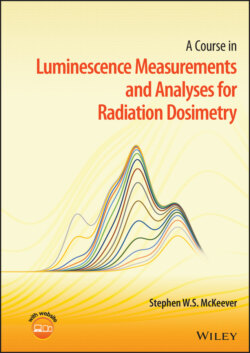Читать книгу A Course in Luminescence Measurements and Analyses for Radiation Dosimetry - Stephen W. S. McKeever - Страница 25
1.3.4 Retrospective Dosimetry
ОглавлениеIn one sense, all passive methods of radiation dosimetry are retrospective in that they produce a measurement of dose only after the dose has been delivered. That is, they integrate the total dose received by the dosimeter since the dosimeter’s last reading. (This is opposed to active dosimeters, which record the dose or dose rate in real time during the exposure period.) However, the term “retrospective” is here reserved for assessing the dose received by an individual who may have undergone an acute exposure during a radiation accident and who may not have been wearing a conventional dosimeter at the time. During radiation accidents (i.e., accidental exposure to a radiation source or contamination by radioactive pollutants), members of the public may be exposed, and since it is not likely that they would have been wearing personal dosimeters, such as those shown in Figure 1.5, methods have to be devised in which estimates may be made of the doses to which they may have been exposed. Regrettably, the potential for intentional exposure of members of the public has also be considered, for example, in terrorist events using so-called dirty bombs (radiation dispersal devices), or even improvised nuclear weapons. Some incidents, be they accidental or intentional, involve only a small number of people, as may the case in an over-exposure of a patient undergoing radiotherapy, or perhaps an accident with an industrial source. In other cases, the number of potentially exposed people could be very large, as in a nuclear power plant accident such as those at Chernobyl (Ukraine) and Fukushima (Japan), or in a terrorist attack.
One approach to these situations, especially to potential large-scale exposure, has been to examine “fortuitous” dosimeters. These are materials that may be found on a person and that may be used as conventional radiation dosimeters. Luminescence, especially TL and OSL, from such materials has been studied extensively for its potential in this application. Examples include TL or OSL from the components of electronic devices (in particular, smartphones), items of clothing and accessory apparel (especially synthetic fibers) and common household materials (such as table salt and ceramic objects). Figure 1.7 shows some examples. Sensitivity to radiation, dose-response characteristics, and fading of the radiation-induced TL or OSL signal are major properties of interest.
Figure 1.7 Potential TL and/or OSL materials for personal retrospective dosimetry. (a) Building materials, including gypsum boards, bricks, ceramic tiles, and concrete blocks. (b) Buttons. (c) Shoes. (d) Smartphone (showing back glass; front protective glass and display glass can also be used). (e) Internal electronic components, including surface mount components and integrated circuits. (f) Materials prepared for TL and/or OSL analysis; top row – surface mount resistors from three different phone models; middle row – integrated circuit fragments; bottom row – protective front glass (left and middle) and display glass (right) from different phone models. Source: All photographs kindly provided by Sergey Sholom; except (c) – provided by the author.
The materials shown in Figure 1.7 are examples of fortuitous luminescence dosimeters for personal dosimetry. That is, they may be used for dose assessment to the individual wearing or possessing the material. In other applications of retrospective dosimetry, such materials are no longer available. This may be the case in after-the-fact dose assessment following acute or chronic events that took place several months or years previously. In these cases, the dose to the built-environment may be determined by extracting suitable materials from that environment to be used as TL or OSL dosimetry materials. Examples include quartz grains extracted from bricks, or ceramic materials such as tiles or electrical insulators, or even washbasins and toilets. Such measurements, when combined with modeling, enable estimates of the dose to air in the vicinity of the building. Time-and-motion modeling of the movement of people within the environment then allows estimation of the doses to which people may have been exposed. Example applications of this kind have included post-event dose assessment at Chernobyl, Hiroshima, and Nagasaki.
